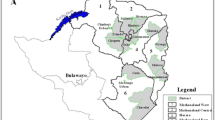Abstract
Tomato yellow leaf curl disease is spreading in southern Europe, where it has quickly become a serious problem. In recent years, several virus isolates have been characterised. Although with some genetic variability, all isolates found in Europe belong to one of two species Tomato yellow leaf curl-Sardinia (TYLCV-Sar) or Tomato yellow leaf curl-Israel (TYLCV-Is). Several methods were tested to identify and type TYLCV isolates from field samples: (1) RFLP of a DNA fragment amplified from the coat protein gene; (2) PAGE of a fragment amplified from the C2 gene; (3) dot-blot hybridisation. All methods enabled the detection of the TYLCVs and provided good indications for attributing them to one species or the other. However, for typing purposes, the RFLP method was the most reliable, due to the easily recognisable pattern produced by the two virus species present in Europe. Dot-blot hybridisation is less expensive for identifying TYLCVs in large numbers of samples, particularly when a mixture of two probes is used. PAGE of the C2 fragment is the fastest of the methods tested.
Similar content being viewed by others
References
Accotto GP, Vaira AM, Noris E and Vecchiati M (1998) Using non radioactive probes on plants: a few examples. J Biolum Chemilum 13: 295–301
Credi R, Betti L and Canova A (1989) Association of a geminivirus with a severe disease of tomato in Sicily. Phytopath Medit 28: 223–226
Crespi S, Accotto GP, Caciagli P and Gronenborn B (1991) Use of digoxigenin-labelled probes for detection and host-range studies of tomato yellow leaf curl virus. Research in Virology 142: 283–288
Crespi S, Noris E, Vaira AM and Accotto GP (1995) Molecular characterization of cloned DNA from a tomato yellow leaf curl virus isolate from Sicily. Phytopath Medit 34: 93–99
Czosnek H and Laterrot H (1997) A worldwide survey of tomato yellow leaf curl viruses. Arch Virol 142:1391–1406
Fauquet MC and Mayo MA (1999) Abbreviations for plant virus names-1999. Arch Virol 144: 1249–1274
Kheyr-Pour A, Bendahmane M, Matzeit V, Accotto GP, Crespi S and Gronenborn B (1991) Tomato yellow leaf curl virus from Sardinia is a whitefly-transmitted monopartite geminivirus. Nucleic Acids Res 19: 6763–6769
Louro D, Noris E, Veratti F and Accotto GP (1996) First report of tomato yellow leaf curl virus in Portugal. Plant Disease 80: 1079
Luisoni E, Milne RG, Gallitelli D, Martelli GP, Antignus Y, Cohen S, Marras F, Idini G, Loche P, Piras S and Leoni S (1989) A geminivirus associated with a severe leaf curl disease of tomato in Sardinia. In: 6th Conference on Recent Advances in VegetableVirus Research, Asilomar, California, August 27–31, (pp 13–14)
Moriones E, Arnò J, Accotto GP, Noris E and Cavallarin L (1993) First report of tomato yellow leaf curl virus in Spain. Plant Disease 77: 953
Navas-Castillo J, Díaz JA, Sánchez-Campos S and Moriones E (1998) Improvement of the print-capture polymerase chain reaction procedure for efficient amplification of DNA virus genomes from plants and insect vectors. J Virol Methods 75: 195–198
Navas-Castillo J, Sánchez-Campos S, Díaz JA, Sáez-Alonso E and Moriones E (1997) First report of tomato yellow leaf curl virus-Is in Spain: coexistence of two different geminiviruses in the same epidemic outbreak. Plant Disease 81: 1461
Navas-Castillo J, Sánchez-Campos S, Díaz JA, Sáez-Alonso E and Moriones E (1999) Tomato yellow leaf curl virus-Is causes a novel disease ofcommonbean and severe epidemics in tomato in Spain. Plant Disease 83: 29–32
Navot N, Pichersky E, Zeidan M, Zamir D and Czosnek H (1991) Tomato yellow leaf curl virus: a whitefly-transmitted geminivirus with a single genomic component. Virology 185: 151–161
Noris E, Hidalgo E, Accotto GP and Moriones E (1994a) High similarity among the tomato yellowleaf curl virus isolates from the West Mediterranean basin: the nucleotide sequence of an infectious clone from Spain. Arch Virol 135: 165–170
Noris E, Accotto GP and Luisoni E (1994b) Advances in diagnosing tomato yellow leaf curl geminivirus infection. Molecular Biotechnology 2: 219–226
Sambrook J, Fritsch EF and Maniatis T (1989) Molecular Cloning: A Laboratory Manual. Cold Spring Harbor Laboratory, Cold Spring Harbor, New York
Wyatt SD and Brown JK (1996) Detection of subgroup III geminivirus isolates in leaf extracts by degenerate primers and polymerase chain reaction. Phytopathology 86: 1288–1293
Author information
Authors and Affiliations
Rights and permissions
About this article
Cite this article
Accotto, G.P., Navas-Castillo, J., Noris, E. et al. Typing of Tomato Yellow Leaf Curl Viruses in Europe. European Journal of Plant Pathology 106, 179–186 (2000). https://doi.org/10.1023/A:1008736023293
Issue Date:
DOI: https://doi.org/10.1023/A:1008736023293




